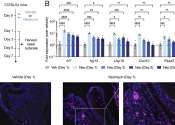An mRNA vaccine strategy under study to fight the flu—as a shot and intranasal spray
Messenger RNA vaccine technology, once an arcane area of research, became household terminology because of the COVID-19 pandemic, and now scientists are working on an mRNA flu vaccine strategy that, at least in this study, ...








